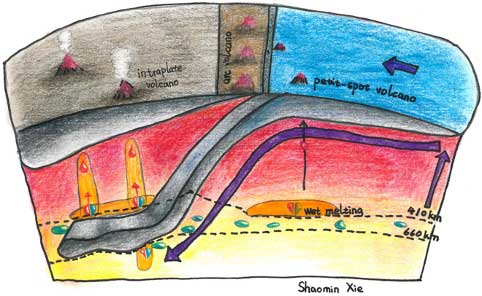 |
Intraplate volcanism originating from upwelling hydrous mantle transition zone |
Jianfeng Yang & Manuele Faccenda
Dipartimento di Geoscienze, Università di Padova, Padova, Italy
This webpage is a summary of Yang, J., and M. Faccenda (2020), Intraplate volcanism originating from upwelling hydrous mantle transition zone, Nature, 579, 88-91.
Most magmatism occurring on Earth is conventionally attributed to passive mantle upwelling at mid-ocean ridges, slab devolatilization at subduction zones, and mantle plumes. However, the widespread Cenozoic intraplate volcanism in northeast China, located more than 1000 km westward of the Japan Trench, and the young alkaline petit-spot volcanoes eastward of the trench, are not associated with any of these mechanisms. Globally, Cenozoic non-hotspot intraplate volcanism is widely distributed in Europe, northeast Africa, east Australia, western USA and east Asia (Conrad et al., 2011; Long et al., 2019). This is generally attributed to small-scale convection (e.g., Elkins-Tanton, 2007), asthenospheric shear (Conrad et al., 2010; Davies & Rawlinson, 2014), slab dehydration (Zhao et al., 2009), slab fragmentation (Liu & Stegman, 2012; Zhou et al., 2018), and subduction-induced upwelling (Faccenna et al., 2010). Nevertheless, none of those mechanisms can simultaneously explain the off-shore and on-shore volcanoes of the Japan Trench. Furthermore, we noticed anomalous low velocity zones (LVZs) above and below the mantle transition zone (MTZ) beneath Japan from seismic tomography images. Volcanoes overlie these LVZs, which encouraged us to consider a linked relationship.
We show that most if not all the intraplate and petit-spot volcanism and LVZs present around the Japanese subduction zone can be explained by Cenozoic interaction of the subducting Pacific slab with a hydrous transition zone. Numerical modelling results indicate that 0.2-0.3 wt.% H2O dissolved in mantle minerals, driven out of the transition zone in response to subduction, and retreat of a stagnant plate and causing partial melting above and below the MTZ, is sufficient to reproduce the observations.

Figure 1: Schematic cartoon illustrating the dynamics of subduction-induced dehydration melting above and below the mantle transition zone and formation of intraplate and petit-spot volcanoes off-shore and on-shore, respectively. The blue ellipsoids indicate wet MTZ. When pushed outside the transition zone, they transform into upper and lower mantle aggregates with low hydrogen solubility, and hydrous partial melting occurs (horizontal domains in orange with blue/red ellipsoids). Large mantle upwellings can be formed in the mantle wedge (vertical domains in orange with red ellipsoids), possibly aided also by slab devolatilization (e.g., Zhao et al., 2009). In contrast, less partial melting is foreseen in the sub-slab upper mantle due to a relatively smaller subduction-induced upwelling. Partial melting in the lower mantle results from slab entrainment of the wet MTZ.
The presence of melt in the deep mantle is mostly catalyzed by thermal anomalies and/or by the involvement of volatiles, such as H2O and CO2. The absence of hotspot tracks likely excludes a thermal anomaly, and we suspect the MTZ is H2O-rich rather than CO2-rich for two reasons:
- the MTZ is primarily composed of wadsleyite and ringwoodite minerals that can accommodate 1-3 wt.% water, which is 1 to 2 orders of magnitude higher than water (hydrogen) solubility in upper and lower mantle minerals. Thus, a wet mantle is expected to result in deep hydrous melting when it is squeezed out of the MTZ by subduction-induced flow, as shown in the numerical models described in our paper;
- although the alkaline and EM1-type petrological and geochemical signature of the basalts requires the presence of reduced carbonated sources and restitic, K-hollandite-bearing sediments, they cannot explain the LVZ below the MTZ. This is because the mantle is more reduced with increasing depth and carbon is more likely to be stable as diamond.
In conclusion, our model suggests that a critical amount of water may have accumulated in the transition zone around this subduction zone as well as others of the Tethyan tectonic belt characterized by intraplate/petit-spot volcanism and LVZs in the underlying mantle.
References
-
Conrad, C.P., Wu, B., Smith, E.I., Bianco, T.A., Tibbetts, A., 2010. Shear-driven upwelling induced by lateral viscosity variations and asthenospheric shear: A mechanism for intraplate volcanism. Phys. Earth Planet. Inter. 178, 162-175.
-
Davies, D.R., Rawlinson, N., 2014. On the origin of recent intraplate volcanism in Australia. Geology 42, 1031-1034.
-
Elkins-Tanton, L.T., 2007. Continental magmatism, volatile recycling, and a heterogeneous mantle caused by lithospheric gravitational instabilities. J. Geophys. Res. Solid Earth 112(B3).
-
Faccenna, C., Becker, T.W., Lallemand, S., Lagabrielle, Y., Funiciello, F., Piromallo, C., 2010. Subduction-triggered magmatic pulses: A new class of plumes? Earth Planet. Sci. Lett. 299, 54-68.
-
Liu, L., Stegman, D.R., 2012. Origin of Columbia River flood basalt controlled by propagating rupture of the Farallon slab. Nature 482, 386.
-
Long, X., Ballmer, M.D., Córdoba, A.M.C., Li, C.-F., 2019. Mantle melting and intraplate volcanism due to self-buoyant hydrous upwellings from the stagnant slab that are conveyed by small-scale convection. Geochem. Geophys. Geosys. 20, 4972-4997.
-
-
Zhao, D., Tian, Y., Lei, J., Liu, L., Zheng, S., 2009. Seismic image and origin of the Changbai intraplate volcano in East Asia: role of big mantle wedge above the stagnant Pacific slab. Phys. Earth Planet. Inter. 173, 197-206.
-
Zhou, Q., Liu, L., Hu, J., 2018. Western US volcanism due to intruding oceanic mantle driven by ancient Farallon slabs. Nat. Geosci., 11(1), 70-76.
last updated 17th
May, 2020 |
